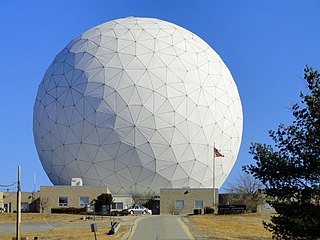 W
WThe 3.67 m Advanced Electro Optical System Telescope is a Department of Defense telescope at Haleakala Observatory. The telescope is part of the Maui Space Surveillance Complex (MSSC), which in turn is part of the Air Force Maui Optical and Supercomputing Site (AMOS).
 W
WThe Air Force Maui Optical and Supercomputing observatory is an Air Force Research Laboratory (AFRL) operating location at Haleakala Observatory on Maui, Hawaii, with a twofold mission. First, it conducts the research and development mission on the Maui Space Surveillance System (MSSS) at the Maui Space Surveillance Complex (MSSC). Second, it oversees operation of the Maui High Performance Computing Center (MHPCC). AFRL's research and development mission on Maui was formally called Air Force Maui Optical Station (AMOS); the use of the term AMOS has been widespread throughout the technical community for over thirty years and is still used today at many technical conferences. The main-belt asteroid 8721 AMOS is named after the project.
 W
WThe AN/FPS-133 Air Force Space Surveillance System, colloquially known as the Space Fence, was a U.S. government multistatic radar system built to detect orbital objects passing over America. It is a component of the US space surveillance network, and according to the US Navy was able to detect basketball sized objects at heights up to 30,000 km
 W
WThe AN/FPS-108 COBRA DANE is a PESA phased array radar installation operated by Raytheon for the United States Air Force at Eareckson Air Station on the island of Shemya, Aleutian Islands, Alaska. This radar system was built in 1976 and brought on-line in 1977 for the primary mission of gathering intelligence about Russia's ICBM program in support of verification of the SALT II arms limitation treaty. Its single face 29 m (95 ft) diameter phased array radar antenna 52.7373°N 174.0914°E faces the Kamchatka Peninsula and Russia's Kura Test Range. COBRA DANE operates in the 1215–1400 MHz band.
 W
WEglin AFB Site C-6 is an Air Force Space Command radar station which houses the AN/FPS-85 phased array radar, associated computer processing system(s), and radar control equipment. Commencing operations in 1969, the AN/FPS-85 was the first large phased array radar. The entire radar/computer system is located at a receiver/transmitter building and is supported by the site's power plant, fire station, 2 water wells, and other infrastructure for the system. As part of the US Air Force's Space Surveillance Network its mission is to detect and track spacecraft and other manmade objects in Earth orbit for "the Joint Space Operations Center satellite catalogue". With a peak radiated power of 32 megawatts the Air Force claims it is the most powerful radar in the world, and can track a basketball-sized object up to 22,000 nautical miles from Earth.
 W
WGlobus II is a radar station located at 70.3671°N 31.1271°E in Vardø, Norway, near the Russian border.
 W
WHaystack Observatory is an astronomical microwave observatory owned by Massachusetts Institute of Technology (MIT). It is located in Westford, Massachusetts (US), approximately 45 kilometers (28 mi) northwest of Boston. Haystack was initially built by MIT's Lincoln Laboratory for the United States Air Force and was known as Haystack Microwave Research Facility. Construction began in 1960, and the antenna began operating in 1964. In 1970 the facility was transferred to MIT, which then formed the Northeast Radio Observatory Corporation (NEROC) with a number of other universities to operate the site as the Haystack Observatory. As of January 2012, a total of nine institutions participated in NEROC.
 W
WPAVE PAWS is an elaborate Cold War early warning radar and computer system developed in 1980 to "detect and characterize a sea-launched ballistic missile attack against the United States". With the first solid-state phased array deployed, the system at the perimeter of the contiguous United States used a pair of Raytheon AN/FPS-115 radar sets at each site as part of the United States Space Surveillance Network. One system was sold to Taiwan and is still in service with that island nation.
 W
WThe Solid State Phased Array Radar System is a USAF radar, computer, and communications system for missile warning and space surveillance "at five (5) geographically separated units worldwide including Beale AFB, CA, Cape Cod, AFS, MA, Clear AFS, AK, RAF Fylingdales, UK, and Thule AB, Greenland." SSPARS completed replacement of the RCA 474L Ballistic Missile Early Warning System when the last SSPAR was operational at Clear in 2001, the year SSPARS equipment included:Raytheon AN/FPS-123 PAVE PAWS Radar at Beale and Cape Cod Raytheon AN/FPS-120 Solid State Phased Array Radar at Thule ("2QFY87") with greater radar capabilities than the FPS-115 PAVE PAWS radars Raytheon AN/FPS-126 Solid State Phased Array Radar at Fylingdales with three faces for 360 degree coverage Raytheon AN/FPS-120 Solid State Phased Array Radar using an older antenna from the 1987 PAVE PAWS EWR in Texas
 W
WThe Space Fence is a second-generation space surveillance system built by the US Air Force in order to track artificial satellites and space debris in Earth orbit.
 W
WThe Space Surveillance Telescope is a telescope for detecting and tracking orbital debris. It has a 3.5 meter (138″) aperture mirror and came online in 2011. Two noted design features include Mersenne-Schmidt type optics and a curved CCD.